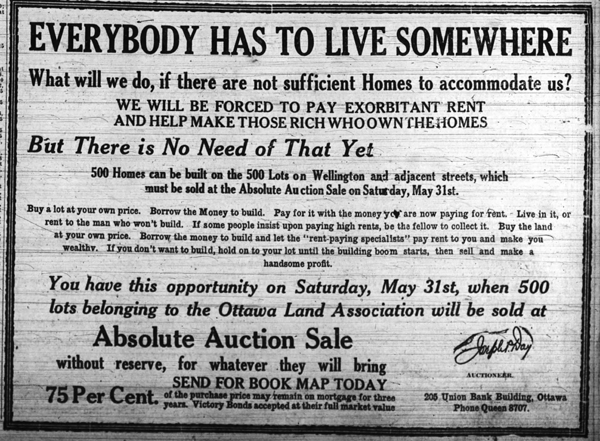Like most of Kitchissippi, Wellington Village began in its earliest days as a farm.
The Stewart family arrived on their property (which stretched from Scott Street south to Carling Avenue) in the early 1830s, and would remain for over 60 years with little change. Ottawa auctioneer and amateur real estate speculator Hector McLean acquired all of the land north of Wellington in the 1870s and created the subdivision of McLeansville, but it failed and the Stewarts reacquired the property. McLean only sold a handful of lots, and just a few homes along this stretch of Richmond Road were built – mostly by Stewart family members – prior to WWI.
Alexander Stewart sold the family farm to the Ottawa Land Association (OLA) in 1893. The syndicate purchased several farms in the area, and then sat on their acquisitions for 30 years, waiting for land values to increase.
In 1919, the Great War ended. Industry was booming and prosperity was widespread, particularly in growing cities like Ottawa which had benefited from the enlarged public service during and after the war. Real estate in the other neighbourhoods bordering what eventually became Wellington Village had been sold off during the real estate boom earlier in the century. With the roaring twenties set to explode, the time was right for the OLA to reap the rewards of their long-term investment. The land was little more than a mix of old farm land, and rocky, tree and brush-covered areas, with a creek winding through it all, but its location bordering Wellington Street and the streetcar track made it extremely desirable.
The OLA hired Joseph P. Day, a famous New York and Chicago auctioneer, to come to Ottawa to publicize the sale and run the auction. Day promoted the potential of the land and implemented a unique approach to sell the lots: a live auction of each of the 500+ lots between Wellington and the Grand Trunk Railway (now the Queensway), one at a time. In the weeks prior to the sale, maps and plans of the site were made available and prospective buyers were invited to visit the new subdivision, inspect the lots, and make their selections. The message to potential buyers was clear: stop paying rent, purchase land for cheap, and build your own home.
The day before the sale – and this may have been strategically timed -– it was announced that the Ottawa Public School Board had purchased 26 of the lots for the purpose of constructing a school. This would be the future Elmdale Public School.
The auction took place at 2 p.m. on May 31, an exceptionally hot day, under what the Journal described as “a mammoth circus tent that was filled to its capacity of 1,500 persons.” The sale generated $140,000 in lot sales, at an average of $248 per lot. Some were sold as low as $75. Interestingly, very few purchasers bought multiple lots. The vast majority were sold to individuals genuinely pulled into the dream of building their own home.
Within days of the auction, building permits were applied for and issued by the City of Ottawa, and construction soon began. But there was a problem. These home-builders were ahead of infrastructure. Heavy petitioning by the property owners brought about the installation of sewers and water mains throughout 1919 and 1920. Roads and sidewalks followed later. Some of the earliest builders lived for months or years without these basic services.
By the summer of 1920, there were approximately 36 houses constructed in Wellington Village. Some even defied the OLA’s building conditions and constructed small wood cottages until they could afford to build proper homes (the conditions were built in to the sale deeds by the OLA to ensure a higher-class neighbourhood, which included the stipulation that each house cost at minimum $2,000 to build, and a prohibition against “any dangerous, noxious, unwholesome or offensive establishment, trade, calling or business, or any nuisance of any kind.”)
In June of 1920, the OLA looked to capitalize on their previous success and held a second auction, for the lots north of Wellington Street. By the mid-summer of 1920, nearly 1,000 lots had been sold by the OLA, and a blitz of home building occurred over the following ten years that would see homes constructed on almost half of them.
The depression and frozen real estate market of the 1930s briefly halted construction, and at least a third of the original auction buyers surrendered their vacant lots to the City due to an inability (or disinterest) to continue to pay taxes. Many were lost for as little as $50 in taxes owing.
By 1945, the construction frenzy returned and it was not too long before nearly every lot had a home. As a result almost all of the homes in the area have a distinct “era” to their construction. Either they were 1920s built, or 1940s built. Additionally, the unique approach of the OLA to sell lots individually ensured that nearly every home was built by a different builder, with a different layout. The great character that defines Wellington Village today is all thanks to a single day in 1919, a circus tent, and the dreams of 500 ordinary Ottawans.
Dave Allston is a local history buff who researches and writes house histories and also publishes a popular blog called The Kitchissippi Museum. His family has lived in Kitchissippi for six generations.
